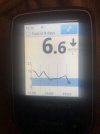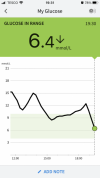-
Please Remember: Members are only permitted to share their own experiences. Members are not qualified to give medical advice. Additionally, everyone manages their health differently. Please be respectful of other people's opinions about their own diabetes management.
You are using an out of date browser. It may not display this or other websites correctly.
You should upgrade or use an alternative browser.
You should upgrade or use an alternative browser.
Phone scanning Libre vs Reader scanning Libre
- Thread starter Lily123
- Start date
- Status
- This thread is now closed. Please contact Anna DUK, Ieva DUK or everydayupsanddowns if you would like it re-opened.
Loobyloo
Well-Known Member
- Relationship to Diabetes
- In remission from Type 2
- Pronouns
- She/Her
I would be happy with that mine is at worst 5.2 on libre and 8.6 on meter. Customer services said 1-2mmols differerence is acceptable (They are sending me replacement sensor). So what you have is very close.
Lily123
Well-Known Member
- Relationship to Diabetes
- Type 1
- Pronouns
- She/Her
What I put must have been confusing. I meant that the reader for the libre (scanning the sensor) read 0.2 lower than my phone scanning the libre sensor within the same minuteI would be happy with that mine is at worst 5.2 on libre and 8.6 on meter. Customer services said 1-2mmols differerence is acceptable. So what you have is very close.
Proud to be erratic
Well-Known Member
- Relationship to Diabetes
- Type 3c
- Pronouns
- He/Him
If I got that I'd be content. The difference of 0.2 is wholly within the accuracy of the 2 devices, your reader and your iPhone. In real terms you can round the number down to 6 for both. When you consider the estimating that is routinely in an accurate carb count, there is no point in getting concerned over such a small difference.I know there’s only a difference of 0.2 but these were taken within the same minute so how are they reading differently?
View attachment 20090
View attachment 20091
Incidentally, I remember you saying in the "which pump" thread that you were going to weigh your cereal the previous evening, so you can get ahead of morning timings. One easy way to get a standard weighed amount of cereal is to use a volume measure. Decide what weight you want, then find a cup/ glass/ small bowl /small jug or any other container that holds exactly that weight - when full to exactly level. No heaping! Then every morning just use that container as your measure for your pre- weighed amount. Its quick and very "repeatable". Also works particularly well for liquids, eg milk. You can't overfill a container with a liquid.
Lily123
Well-Known Member
- Relationship to Diabetes
- Type 1
- Pronouns
- She/Her
I thought the Libre took a reading a minute and then scanning twice within the same minute would get the same result? I must be confused with something else.If I got that I'd be content. The difference of 0.2 is wholly within the accuracy of the 2 devices, your reader and your iPhone. In real terms you can round the number down to 6 for both. When you consider the estimating that is routinely in an accurate carb count, there is no point in getting concerned over such a small difference.
Incidentally, I remember you saying in the "which pump" thread that you were going to weigh your cereal the previous evening, so you can get ahead of morning timings. One easy way to get a standard weighed amount of cereal is to use a volume measure. Decide what weight you want, then find a cup/ glass/ small bowl /small jug or any other container that holds exactly that weight - when full to exactly level. No heaping! Then every morning just use that container as your measure for your pre- weighed amount. Its quick and very "repeatable". Also works particularly well for liquids, eg milk. You can't overfill a container with a liquid.
That is a good idea to try with the cereal but I’ve stopped eating cereal in exchange for yogurt and a Nature Valley bar (not enough time to get everything done in the morning, I wake up at ten to seven) If I do go back to cereal I will definitely use that for weight.
To be being 2 out is a bit to much for me I can deal with it being 1 out but I don't like the idea of something saying 5.4 for example when it couldbe 3.4I would be happy with that mine is at worst 5.2 on libre and 8.6 on meter. Customer services said 1-2mmols differerence is acceptable (They are sending me replacement sensor). So what you have is very close.
Lily123
Well-Known Member
- Relationship to Diabetes
- Type 1
- Pronouns
- She/Her
Libre is calibrated to normal levels (I’m not sure what levels are regarded as normal in this sense) so the Libre might read higher at high numbers and lower at low numbersTo be being 2 out is a bit to much for me I can deal with it being 1 out but I don't like the idea of something saying 5.4 for example when it couldbe 3.4
PattiEvans
Well-Known Member
- Relationship to Diabetes
- Type 1
- Pronouns
- She/Her
I think Lily is talking about 0.2 not 2mmol out.To be being 2 out is a bit to much for me I can deal with it being 1 out but I don't like the idea of something saying 5.4 for example when it couldbe 3.4
Lily123
Well-Known Member
- Relationship to Diabetes
- Type 1
- Pronouns
- She/Her
I didn’t mean by a finger prick compared to Libre , I meant my phone and the reader both scanning the Libre within the same minute giving slightly different results. Yes I meant 0.2I think Lily is talking about 0.2 not 2mmol out.
Yes sorry I know proberry shouldn't have interumptedI think Lily is talking about 0.2 not 2mmol out.
Lily123
Well-Known Member
- Relationship to Diabetes
- Type 1
- Pronouns
- She/Her
Nothing to be sorry forYes sorry I know proberry shouldn't have interumpted
Lily123
Well-Known Member
- Relationship to Diabetes
- Type 1
- Pronouns
- She/Her
That was my thinking - that they were using slightly different algorithms but a difference of 0.2 isn’t that major it did confuse meHi @Lily123, I'm not sure if anyone else is following what you are saying, but I am. You are using the official Libre reader to scan your Libre sensor, and also scanning the same Libre sensor using the Libre app on your phone. They are showing a difference of 0.2
My best guess is that the algorithm used in the scanner device is older than the algorithm used in the app on your phone. Abbott are now concentrating on the phone app, and currently have no plans to release a scanner for Libre 3. So, further firmware updates for the Official scanner may or may not happen, but the software for your phone will be updated as required.
Lily123
Well-Known Member
- Relationship to Diabetes
- Type 1
- Pronouns
- She/Her
Yes I did scan again and both said 6.2 and stableThe data received by both devices from the sensor is exactly the same, the algorithms interpret slightly differently, trying to reduce the lag that we notice when we compare against finger pricking. I assume the phone app should be doing a better job, most of the time.
The way to check if it is to reduce the lag, is to do the same comparison when your glucose level is dead flat. The values should be the same.
Lily123
Well-Known Member
- Relationship to Diabetes
- Type 1
- Pronouns
- She/Her
I have an iPhone so can’t use xDrip - I normally don’t use the reader but fancied a change and the alarms are less of an annoying sound on the readerGood.
I use the Libre app on my phone, side by side with the xDrip app. It's the same data going through both programs but different algorithms and in the case of xDrip calibrations to interpret that data. So, quite similar to your situation.
Lily123
Well-Known Member
- Relationship to Diabetes
- Type 1
- Pronouns
- She/Her
I know, it would be helpful for something like xDrip for iPhones or for xDrip to work on iPhones as calibrating the Libre would be helpfulI wasn't pushing xDrip, I just used it as an example
There is a xDrip for iPhones. I think it is called xDrip4iOS.I know, it would be helpful for something like xDrip for iPhones or for xDrip to work on iPhones as calibrating the Libre would be helpful
i am afraid that, beyond the name, I know very little about it.
Lily123
Well-Known Member
- Relationship to Diabetes
- Type 1
- Pronouns
- She/Her
Ah, I may have to do some research about thatThere is a xDrip for iPhones. I think it is called xDrip4iOS.
i am afraid that, beyond the name, I know very little about it.
Proud to be erratic
Well-Known Member
- Relationship to Diabetes
- Type 3c
- Pronouns
- He/Him
No, I don't think you are confused. Although you are taking readings within 1 minute, perhaps within 20 seconds, you don't know whether the first reading was within the previous minute for the sensor and the second reading was from the next minute for the sensor!I thought the Libre took a reading a minute and then scanning twice within the same minute would get the same result? I must be confused with something else.
When does sensor time start??? This philosophical (and unanswerable) question could become a great time waster!
I thought it was every 5 minutes not every minute?No, I don't think you are confused. Although you are taking readings within 1 minute, perhaps within 20 seconds, you don't know whether the first reading was within the previous minute for the sensor and the second reading was from the next minute for the sensor!
When does sensor time start??? This philosophical (and unanswerable) question could become a great time waster!
- Status
- This thread is now closed. Please contact Anna DUK, Ieva DUK or everydayupsanddowns if you would like it re-opened.


